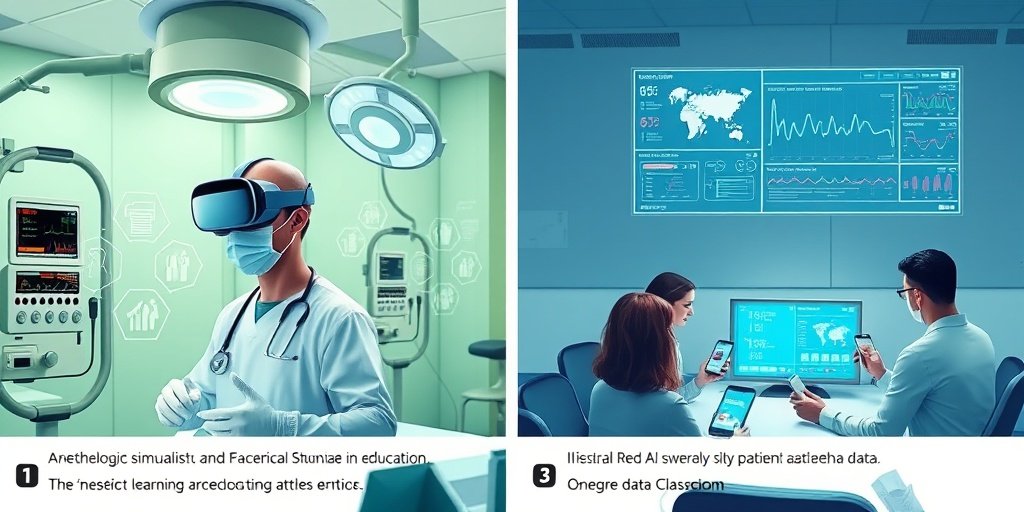⚡ Quick Summary
This review highlights the evolving landscape of patient safety education in anesthesiology, emphasizing the integration of emerging technologies such as artificial intelligence (AI) and immersive reality (IR). These innovations promise to enhance educational practices, making them more personalized and effective in reducing medical errors.
🔍 Key Details
- 📚 Focus: Patient safety education in anesthesiology
- 🛠️ Technologies explored: AI, immersive reality (IR), gamification, mobile platforms
- 📈 Current state: Lack of standardization in content, delivery, and assessment
- 🔍 Teaching strategies: Structured clinical training, simulation, quality improvement projects
🔑 Key Takeaways
- 📊 Patient safety education is critical for reducing medical errors in anesthesiology.
- 💡 Emerging technologies like AI and IR are gaining traction in educational settings.
- 🧩 AI can tailor instruction and identify high-risk learners effectively.
- 🌐 Immersive reality offers tools for both technical and nontechnical skills training.
- 📉 Current limitations include fixed curricula and accessibility issues.
- 🔄 Innovations require robust validation for effective integration into education.
- 🏆 Structured training and simulation remain common but are evolving.
- 🔗 Collaboration among educators and technologists is essential for progress.

📚 Background
In the field of anesthesiology, patient safety education is paramount to minimizing medical errors and ensuring optimal patient outcomes. However, the current educational frameworks often lack the necessary standardization and adaptability to meet the diverse needs of learners. As technology advances, there is a growing opportunity to leverage these tools to enhance educational practices and improve safety outcomes.
🗒️ Study
This review examines the current state of patient safety education in anesthesiology, focusing on the integration of emerging technologies. The authors explore various teaching strategies, including traditional methods and innovative approaches such as gamification and mobile learning platforms, to identify best practices and potential areas for improvement.
📈 Results
The findings indicate that while traditional methods like structured clinical training and simulation are prevalent, there is a significant shift towards incorporating AI and immersive reality into educational frameworks. These technologies offer the potential for more personalized and interactive learning experiences, addressing the limitations of fixed curricula and enhancing accessibility for learners.
🌍 Impact and Implications
The integration of technology in patient safety education could revolutionize anesthesiology training. By utilizing AI and immersive reality, educators can create adaptive learning environments that cater to individual learner needs, ultimately leading to improved patient safety outcomes. This shift not only enhances the educational experience but also prepares future anesthesiologists to navigate complex clinical scenarios more effectively.
🔮 Conclusion
The future of anesthesia education is bright, with the potential for technology-driven innovations to reshape how patient safety is taught. As we embrace these advancements, it is crucial to ensure that they are validated and thoughtfully integrated into existing educational frameworks. Continued research and collaboration will be key to unlocking the full potential of these technologies in enhancing patient safety education.
💬 Your comments
What are your thoughts on the integration of technology in anesthesia education? We would love to hear your insights! 💬 Share your comments below or connect with us on social media:
The future of anesthesia education: incorporating technology for safer practices.
Abstract
PURPOSE OF REVIEW: Although effective patient safety education is critical to reducing medical errors, little guidance exists on best practices for patient safety curricula. This review explores the current state of patient safety education in anesthesiology and highlights emerging technologies as tools to enhance and personalize education.
RECENT FINDINGS: Despite formal mandates from accrediting bodies, patient safety education in anesthesiology lacks standardization in content, delivery, and assessment. Structured clinical training, simulation, and quality improvement projects are common teaching strategies, but novel approaches such as immersive reality (IR), artificial intelligence (AI)-powered agents, gamification, and mobile platforms are gaining traction. AI shows promise in tailoring instruction and identifying high-risk learners, and IR offers tools for both technical and nontechnical skills training.
SUMMARY: Patient safety education in anesthesiology is evolving with technology. AI and digital tools provide adaptive and interactive learning experiences that may help address current limitations in fixed, generalized curriculum structure and accessibility. However, these innovations require robust validation and thoughtful integration into educational frameworks to realize their full potential.
Author: [‘Yu S’, ‘Bettini LM’, ‘Harbell MW’]
Journal: Curr Opin Anaesthesiol
Citation: Yu S, et al. The future of anesthesia education: incorporating technology for safer practices. The future of anesthesia education: incorporating technology for safer practices. 2025; (unknown volume):(unknown pages). doi: 10.1097/ACO.0000000000001559